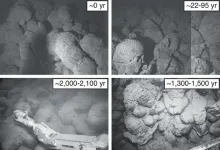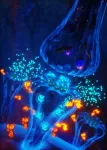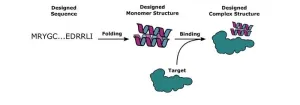(Press-News.org) As little as 25 minutes a day of slow walking seems to be enough to counter the detrimental physical effects of bedrest on older hospital patients, finds a pooled data analysis of the available evidence, published online in the British Journal of Sports Medicine.
And for optimal improvements in physical function, around 50 mins/day of slow walking or around 40 mins of combined physical activities, such as 20 mins of resistance bands with around 20 mins of aerobic activity, are the most effective, the analysis indicates.
But there may be a threshold effect, with no clear benefit for ‘doses’ of more than 90 mins/day of light intensity, or 60 mins/day of moderate intensity, physical activity, it finds.
Older people admitted to hospital, even those who can walk unaided by themselves, spend most of their stay in bed. But this level of inactivity can cause ‘post hospital syndrome’---a period of vulnerability after discharge associated with general physical deconditioning.
If not actively managed, this may have various consequences, including readmission, disability, the need for nursing home care, illness, or death, emphasise the researchers.
Recently published research indicates that getting older hospital patients out of bed and moving about can help ward off physical decline, but it’s not clear what type of activity, or how much of it, might be most effective.
In a bid to find out, the researchers looked for published clinical trials that involved people over the age of 50 who had been admitted to hospital for a serious bout of illness and prescribed any form of physical activity during their inpatient stay.
They included only those trials that involved a comparison group receiving usual care or another type of physical activity; that assessed changes in functional capacity—ability to perform routine activities of daily living, for example—and that recorded any adverse consequences, at discharge or at any subsequent monitoring point.
Nineteen clinical trials out of an initial haul of 44, involving 3842 participants and published between 2000 and 2022, were included.
The final analysis included 3783 participants, over half of whom 2087 (55%) were women, ranging in age from 55 to 87. Their average length of stay was 7 days; and the average monitoring period after discharge was 68 days.
Pooling the trial results showed that the minimal ‘dose’ required to counter the effects of bedrest and improve older inpatients’ functional capacity was estimated to be around 40 mins/day of light intensity physical activity or around 25 mins/day of moderate intensity physical activity.
And the optimal ‘dose’ was estimated to be 70 mins/day of light intensity, or around 40 mins/day of moderate intensity physical activity.
There was no clear benefit for ‘doses’ of more than 90 mins/day of light intensity, or 60 mins/day of moderate intensity physical activity, suggesting a threshold effect.
In terms of the best type of physical activity to ward off physical decline, a mix of physical activity in any one daily session and slow-paced walking were deemed the most effective.
But only walking was more than 80% effective, with the optimal dose reached at around 50 mins/day, and the minimal effective dose reached at 25 mins/day.
The analysis showed that the effectiveness of physical activity interventions increased from admission to discharge, peaking at around 19 days after discharge.
The fall rate, the most common occurrence after discharge, was similar among the intervention and comparison groups, but those prescribed physical activity experienced fewer adverse consequences, overall, than those given usual care.
The researchers acknowledge that there was little information on monitoring frequency after discharge and that only participants who were able to move unaided were included, both of which may weaken the findings and limit their wider applicability.
But they point out: “Older adults are projected to comprise more than 60% of the total hospital inpatient population by 2030. Based on the existing evidence to date, this review has shown the optimal type and dose of physical activity necessary to prevent functional decline and reduce adverse events in older adults admitted to hospital.”
And they conclude: “If the most potent intervention is provided [walking], the beneficial effects of in-hospital supervised physical activity programmes can be maximised with as little as around 25 mins/day of slow-paced walking, an achievable target for most hospitalised older adults.
“Together, this meta-analysis has yielded critical information to support the use of physical activity as a core part of the daily routine of acutely hospitalised older adults.”
END
Walking 25 mins/day enough to counter physical impact of bedrest on older hospital patients
And daily 50 mins of slow walking or 40 mins of mix of physical activities, even better….
2023-08-04
ELSE PRESS RELEASES FROM THIS DATE:
New exoplanet discovery builds better understanding of planet formation
2023-08-04
An international team of scientists have discovered an unusual Jupiter-sized planet orbiting a low-mass star called TOI-4860, located in the Corvus constellation.
The newly discovered gas giant, named TOI-4860 b, is an unusual planet for two reasons: stars of such low mass are not expected to host planets like Jupiter, and the planet appears to be particularly enriched by heavy elements.
The study, led by University of Birmingham astronomers, is published today (Friday 4th August) in a letter published within the Monthly Notices of the Royal Astronomical Society.
The planet was initially identified using NASA’s Transiting Exoplanet ...
Novel machine learning blood test detects cancers with genome-wide mutations in single molecules of cell-free DNA
2023-08-04
Novel blood testing technology being developed by researchers at the Johns Hopkins Kimmel Cancer Center that combines genome-wide sequencing of single molecules of DNA shed from tumors and machine learning may allow earlier detection of lung and other cancers.
The test, called GEMINI (Genome-wide Mutational Incidence for Non-Invasive detection of cancer), looks for changes to DNA throughout the genome. First, a blood sample is collected from a person at risk for developing cancer. Then, cell-free DNA (cfDNA) shed by tumors is extracted from the plasma and sequenced using cost-efficient ...
Research reveals Hawai‘i’s undersea volcano, Kama‘ehu, erupted five times in past 150 years
2023-08-04
Kamaʻehuakanaloa (formerly Lōʻihi Seamount), a submarine Hawaiian volcano located about 20 miles off the south coast of the Big Island of Hawai‘i, has erupted at least five times in the last 150 years, according to new research led by Earth scientists at the University of Hawai‘i at Mānoa. For the first time, scientists were able to estimate the ages of the most recent eruptions of Kamaʻehu, as well as the ages of eight additional older eruptions at this volcano going back about 2,000 years. Their findings were published recently in Geology.
Hawaiian volcanoes are thought to transition through a series of growth stages. ...
Insulin-like hormones critical for brain plasticity
2023-08-04
Research from the Max Planck Florida Institute for Neuroscience has identified a mechanism through which insulin-like growth factors facilitate brain plasticity.
The insulin superfamily of hormones, including insulin, insulin-like growth factor 1 (IGF1), and insulin-like growth factor 2 (IGF2), play a crucial role not only in regulating blood sugar, metabolism, and growth, but also in healthy brain development and function, including learning and memory. These hormones can enter the brain through the bloodstream from the liver or can be synthesized directly in neurons and glial cells within the brain. They bind to receptors, ...
A mother’s diet can protect her grandchildren’s brains: genetic model study
2023-08-04
Mothers who eat apples and herbs in early pregnancy could be protecting the brain health of their children and grandchildren, a Monash University study using genetic models has found.
The discovery is part of a project that found a mother’s diet can affect not just her child’s brain but also those of her grandchildren.
Published in Nature Cell Biology, the Monash Biomedicine Discovery Institute study found that certain foods could help protect against the deterioration of brain function.
More specifically, the study used roundworms (Caenorhabditis elegans) as the genetic model because many of ...
Study examines Earth and Mars to determine how climate change affects the paths of rivers
2023-08-04
In a new study published in Nature Geosciences, researchers, led by a Tulane University sedimentologist , investigated why the paths of meandering rivers change over time and how they could be affected by climate change.
Chenliang Wu, PhD, a postdoctoral researcher at Tulane University School of Science and Engineering, began this research by looking at the Mississippi River before adding other rivers on Earth and ancient riverbeds on Mars to the study.
The study specifically looks at river sinuosity, or how much rivers curve. The sinuosity of rivers changes over time, depending on the age of the river and environmental changes. Some of these changes ...
MSU scientists help discover the highest-energy light coming from the sun
2023-08-03
EAST LANSING, Mich. – Sometimes, the best place to hide a secret is in broad daylight. Just ask the sun.
“The sun is more surprising than we knew,” said Mehr Un Nisa, a postdoctoral research associate at Michigan State University. “We thought we had this star figured out, but that’s not the case.”
Nisa, who will soon be joining MSU’s faculty, is the corresponding author of a new paper in the journal Physical Review Letters that details the discovery of the highest-energy ...
Outdoor air pollution may increase non-lung cancer risk in older adults
2023-08-03
Key points:
A cohort study of millions of Medicare beneficiaries found that chronic exposures to PM2.5 and NO2 over a 10-year period increased the risk of developing colorectal and prostate cancers.
Even in areas with low pollution levels, researchers found substantial associations between exposures to these pollutants and the risk of developing colorectal and prostate cancers, in addition to breast and endometrial cancers.
For immediate release: August 3, 2023
Boston, MA—Chronic exposure to fine particulate air pollutants (PM2.5) ...
University of Minnesota-led study links long-term artificial sweetener intake to increased body fat adipose tissue volume
2023-08-03
MINNEAPOLIS/ST. PAUL (08/03/2023) — Published in the International Journal of Obesity, University of Minnesota Medical School and School of Public Health researchers led a study on the relationship between dietary intake and cardiovascular disease risk factors.
Over 20 years, the research team examined people's regular dietary intake, paying particular attention to non-nutritive sweeteners commonly found in artificial sweeteners. They found that long-term consumption of aspartame, saccharin and diet beverages were linked to increased fat stores in the abdomen and fat within muscle. However, ...
Deep learning for new protein design
2023-08-03
The key to understanding proteins — such as those that govern cancer, COVID-19, and other diseases — is quite simple. Identify their chemical structure and find which other proteins can bind to them. But there’s a catch.
“The search space for proteins is enormous,” said Brian Coventry, a research scientist with the Institute for Protein Design, University of Washington and The Howard Hughes Medical Institute.
A protein studied by his lab typically is made of 65 amino acids, and ...
LAST 30 PRESS RELEASES:
Multifaceted effects of inward foreign direct investment on new venture creation
Exploring mutations that spontaneously switch on a key brain cell receptor
Two-step genome editing enables the creation of full-length humanized mouse models
Pusan National University researchers develop light-activated tissue adhesive patch for rapid, watertight neurosurgical sealing
Study finds so-called super agers tend to have at least two key genetic advantages
Brain stimulation device cleared for ADHD in the US is overall safe but ineffective
Scientists discover natural ‘brake’ that could stop harmful inflammation
Tougher solid electrolyte advances long-sought lithium metal batteries
Experts provide policy roadmap to reduce dementia risk
New 3D imaging system could address limitations of MRI, CT and ultrasound
First-in-human drug trial lowers high blood fats
Decades of dredging are pushing the Dutch Western Scheldt Estuary beyond its ecological limits
A view into the innermost workings of life: First scanning electron microscope with nanomanipulator inaugurated in hesse at Goethe University
Simple method can enable early detection and prevention of chronic kidney disease
S-species-stimulated deep reconstruction of ultra-homogeneous CuS nanosheets for efficient HMF electrooxidation
Mechanical and corrosion behavior of additively manufactured NiTi shape memory alloys
New discovery rewrites the rules of antigen presentation
Researchers achieve chain-length control of fatty acid biosynthesis in yeast
Water interactions in molecular sieve catalysis: Framework evolution and reaction modulation
Shark biology breakthrough: Study tracks tiger sharks to Maui mating hub
Mysterious iron ‘bar’ discovered in famous nebula
World-first tool reduces harmful engagement with AI-generated explicit images
Learning about public consensus on climate change does little to boost people’s support for action, study shows
Sylvester Cancer Tip Sheet for January 2026
The Global Ocean Ship-Based Hydrographic Investigations Program (GO-SHIP) receives the Ocean Observing Team Award
Elva Escobar Briones selected for The Oceanography Society Mentoring Award
Why a life-threatening sedative is being prescribed more often for seniors
Findings suggest that certain medications for Type 2 diabetes reduce risk of dementia
UC Riverside scientists win 2025 Buchalter Cosmology Prize
SETI Institute opens call for nominations for the 2026 Tarter Award
[Press-News.org] Walking 25 mins/day enough to counter physical impact of bedrest on older hospital patientsAnd daily 50 mins of slow walking or 40 mins of mix of physical activities, even better….



